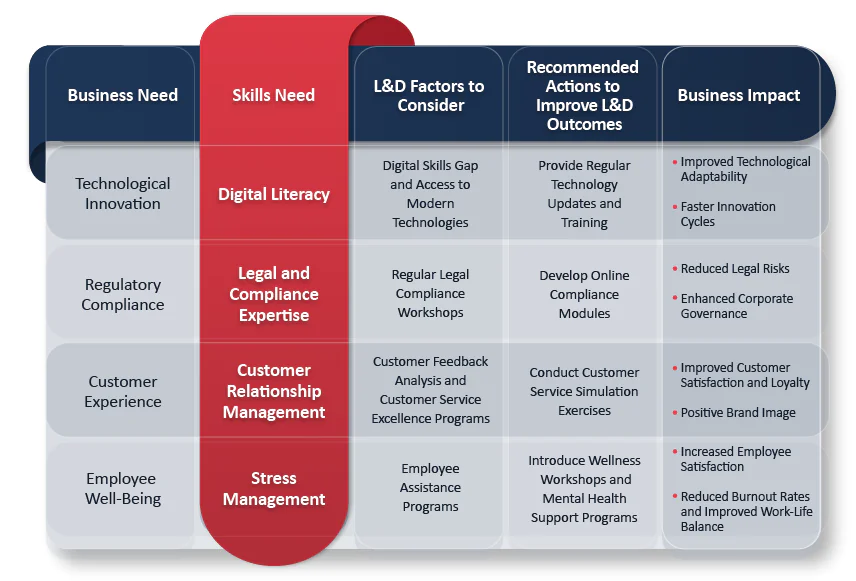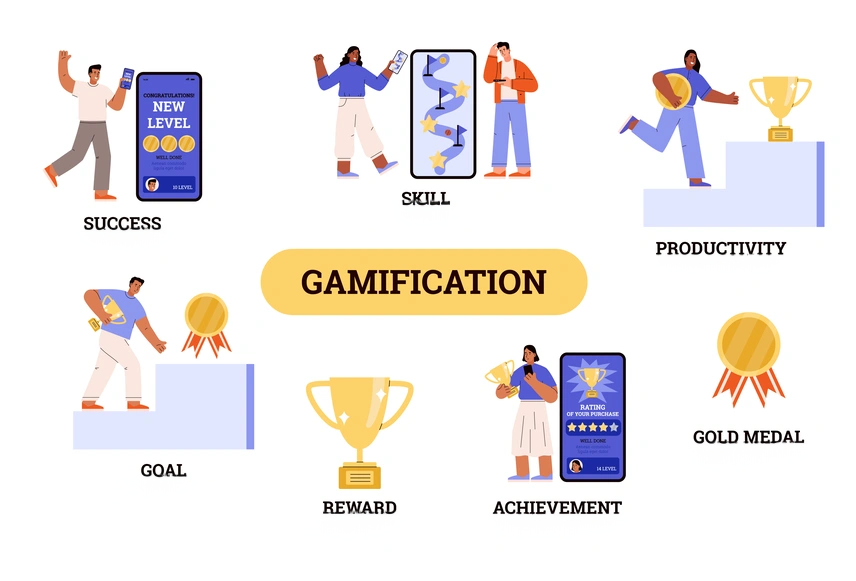
The biggest eLearning trends and L&D advancements are about to take center stage. The eLearning landscape is continuously evolving to shape the future of learning in 2024 and beyond. It’s time that global organizations embrace these transformative shifts to prepare their workforce for the challenges and opportunities that lie ahead.
According to Gartner, enhancing all aspects of learning support can increase employee growth by up to 45%. Another report by LinkedIn says providing learning opportunities is the #1 way organizations are working to improve retention. These statistics clearly define the importance of strategic learning initiatives in building the future workforce.
With a seamless progression from eLearning trends 2023, we bring an exclusive eLearning Trends 2024 guide to the rescue. Today, we will explore the emerging trends and technology-based inclinations in eLearning and L&D that are bound to create exceptional learning experiences. Let’s get started!
10 Biggest eLearning Trends and L&D Predictions to Follow in 2024
eLearning trends and L&D predictions for 2024 feature interactive corporate training frameworks, innovative eLearning strategies, and cutting-edge L&D technologies that will define the next phase of digital learning. Keeping pace with the L&D and eLearning trends will be crucial for organizations wanting to create a lasting impact in the new year.
1. AI in eLearning and L&D
AI stands among the top L&D predictions and eLearning trends for 2024. AI is now being talked more about in the context of “Augmented Intelligence” rather than “Artificial Intelligence,” and it is being utilized very effectively by L&D. Organizations need to embrace this trend to revolutionize their eLearning strategies.
By leveraging AI technologies like Natural Language Processing (NLP), Machine Learning (ML), Large Language Models (LLM), language transformers, predictive analytics, and GenAI, L&D leaders can:
- Automate L&D tasks.
- Gather intelligent insights on learner progress.
- Improve productivity.
- Deliver personalized learning experiences.
For example, organizations can use AI models and transformers to automate skills gap analysis. This will help them recommend targeted training modules, adapt learning content based on their preferences, and deliver learner-centric upskilling content.
According to Statista, AI and ML technologies play a vital role in delivering customized learning experiences. Another report by HR Exchange Network states that 33% of C-suite executives agree L&D will be the #3 most important area to be impacted by GenAI. AI is easily one of the most critical eLearning trends that has the potential to create a valuable impact on the future of learning.
Integrating GenAI in L&D can transform how eLearning content is created and delivered. It can help L&D leaders unlock new dimensions of efficiency, engagement, and effectiveness through their eLearning initiatives at scale. A use case is for using a trained GenAI T5 model for content production such as automating question generation for course development.
Organizations need to leverage AI-based learning solutions to successfully navigate the learning content landscape and meet their eLearning objectives. This is where the Harbinger iContent Framework can help. Our intelligent content automation framework powered by GenAI technologies can help L&D professionals future-proof eLearning content development through various remarkable capabilities:
- Automated translation and transcription for all kinds of content (video, docs, and eLearning courses)
- Matching and content recommendation
- Automated question generation and personalized nudges
- Skim generation and summary creation
- Voice over conversion
- Extraction, republishing, and accessibility checking
- AI-based parsing and tagging
- Automated searching and ranking
2. Skills-Based L&D
Skills-based L&D is one of the most essential eLearning trends organizations can’t afford to miss in 2024. This trend reflects a massive shift from traditional L&D models to a more targeted and outcomes-driven approach. It emphasizes acquiring and enhancing specific skills directly applicable to individual roles and organizational goals.
According To LinkedIn’s 2023 Workplace Learning Report, Approximately 50% Of Skill Sets For Jobs Will Change By 2027. The Report Also States That 89% Of L&D Leaders Agree That Proactively Developing Employee Skills Will Successfully Meet The Evolving Needs Of The Future Of Work.
The shift toward skills-based L&D is driven by the recognition that the modern workplace requires a workforce with a versatile skill set. L&D leaders need to create a maturity model for corporate L&D.
They also need to build an L&D strategy backed by a skills-based approach that not only focuses on learning content consumption but prioritizes learning opportunities, skill preparedness, and skill application.
Here’s an example of a skills-based L&D framework that can help you make the right decision and build an agile L&D strategy for your company.

3. Reskilling, Upskilling, and Cross-Skilling
Another step to building a skills-based L&D strategy demands leveraging one of the most crucial eLearning trends and L&D predictions for 2024 which highlight the importance of reskilling, upskilling, and cross-skilling. These factors are important to ensure the workforce remains agile and adaptive to rapidly evolving industry landscapes.
According to The World Economic Forum’s 2023 Future of Jobs report, 6 out of 10 employees will need training before 2027. Another report by Korn Ferry predicts a talent shortage of more than 85 million by 2030. The only plausible solution to overcome this challenge is to upskill, reskill, and cross-skill with an ongoing commitment to expanding the skillsets of the current and future workforces. No wonder these strategies have secured a place in the top eLearning trends for 2024.
Reskilling empowers employees to acquire new competencies relevant to emerging technologies and changing job requirements. Upskilling becomes instrumental in enhancing proficiency in their current roles. Additionally, cross-skilling fosters versatility among employees, enabling them to diversify their skill set and contribute across various functions within the organization.
According to Coursera, the top 5 factors driving urgency for reskilling and upskilling programs are:
- Increasing productivity
- Keeping up with the competition
- Driving employee engagement
- Changing technologies
- Employee retention
4. Custom eLearning Development
eLearning development can never tick the ‘one-size-fits-all’ checkbox. Why? Because every learner possesses unique strengths, preferences, and learning styles. The diversity in individual backgrounds, prior knowledge, and skill levels demands a more personalized and adaptive approach to learning content creation and delivery.
This scenario calls for a custom eLearning development approach – making it one of the dominant eLearning trends for 2024. This customized approach caters to the varied needs of learners through:
- eLearning development using authoring tools like Articulate 3/360, Captivate, dominKnow, and iSpring.
- AI-based chatbot development for just-in-time learning.
- Game-based learning and gamified process and product training.
- Microlearning, bite-sized nuggets, and chunking large courses into smaller modules.
- Nudge-learning to reinforce learning content.
5. Gamification in eLearning

Gamification is one of those eLearning trends which have never died, and it continues to be in the list of eLearning trends 2024 as well. With gamification, organizations can increase learning retention, motivate employees, and drive employee engagement. One can incorporate game elements such as points, badges, leaderboards, and interactive challenges to infuse a sense of excitement and competition into their eLearning programs.
Gamification can be the best bet for various eLearning use cases like employee onboarding training, compliance training, soft skills development, product training, language learning, customer service training, and sales training.
Recently, Harbinger helped a global healthcare products and services provider transform blended learning for medical sales professionals by introducing gamification in sales training. Self-led gamification modules helped learners complete the program at their own pace and simplified sales training.
Harbinger has been helping global organizations elevate the learner experience and create impactful learning through our easy-to-use, fully customizable, and plug-and-play gamification framework. This framework rapidly adds gamification elements to eLearning in a cost-effective way through its transformative capabilities and features like:
- HTML5 game development.
- Game development using authoring tools like Storyline 360, Adobe Captivate, and dominKnow.
- Gamified dashboard and templates without LMS.
- Character-based and multi-level game design.
- Easy editing, maintenance, and gamification of content across modules.
L&D leaders can leverage our custom gamified eLearning solutions to take advantage of elements like gamification of existing courses, game-based learning, scenario-based learning, gamified assessments, and gamified LMS integration.
Furthermore, organizations can enable gamified learning using GenAI. This will help them improve engagement levels, promote active participation, bridge the gap between theoretical knowledge and practical application, and deliver engaging learning experiences.
6. Learning Analytics
Another concept that stands among the most useful eLearning trends to watch out for is learning analytics. It provides valuable insights into learner progress, engagement levels, and performance to make informed decisions.
By leveraging data-driven insights, learning analytics can help personalize the learning experience, identify areas for improvement, and predict future learning requirements. It will play a key role in optimizing learning outcomes and fostering a more adaptive and personalized learning environment.
Organizations can integrate learning analytics into every aspect of the learning journey to take advantage of its various features and functionalities:
- Competency-wise individual, group, and team analytics and comparison.
- Visual depiction of improvement in performance.
- Custom learning dashboard for individuals and managers.
- Usage analytics and learner engagement analytics.
- Learning record store setup.
7. Translation and Localization of Training Content
One of the most remarkable L&D and eLearning trends organizations need to track in 2024 is the translation and localization of training content. Many companies are already implementing localization strategies to train and instruct their employees and customers. This helps with:
- Promoting DEI in L&D initiatives and the workplace in general
- Ensuring active participation and better learning and engagement
- Building employee and customer loyalty and strong corporate culture
- Ensuring consistency, precision, and accuracy in training content
- Conveying universal messages to a diverse workforce
As part of the eLearning trends for 2024, L&D will invest more in practices that involve translating training content for non-native English speakers in their native languages. This is where recent advancements in AI and prompt engineering will offer a great deal of help. They can not only automate the translation of training content in desired languages but also the localization part which involves adapting the content to a specific language, regional dialect, cultural context, and consumption preference.
For instance, GenAI-based automated translation can instantly translate an eLearning course to create culture-specific content or localize existing content based on the target audience. It can help cut down translation and audio recording costs and minimize the manual efforts required to integrate translated text into the content.
Harbinger’s GenAI-powered translation solution, iTranslate, is a good example to look at. It helps customers rapidly translate a substantial volume of content in 100+ languages. It can translate content in various formats such as PPT, PDF, Docx, XLF, and Video, achieving remarkable accuracy rates ranging from 90% to 95%. For selected languages, the accuracy is as good as 100%.
iTranslate seamlessly integrates with external AI LLMs and platforms like GPT-4 via APIs to deliver transformative learning experiences. It uses machine-to-machine (M2M) communication technology to enable efficient content translation while reducing manual work and integration errors.
Using the traditional translation approach, it would take approximately 1.5 to 2 years to translate over 950 hours of video content in a minimum of 4 languages. However, with iTranslate, such a scale of translation work can be completed in as low as 6 months.
8. Accessibility in eLearning

Accessibility is another concept that stands among the most significant eLearning trends for 2024. Accessibility reflects a growing commitment to inclusivity and diversity in eLearning. With an increasing awareness of diverse learning needs, L&D professionals need to prioritize developing and implementing accessibility features.
The integration of accessibility features not only meets regulatory requirements but also enhances the overall learning experience. It can help organizations make eLearning more equitable and impactful for a broader audience. Moreover, advancements like voice-activated controls, AI-driven personalization, and responsive design are an add-on.
eLearning accessibility goes beyond mere compliance with accessibility standards. It signifies a proactive approach to fostering an inclusive learning environment where individuals with varying abilities can seamlessly engage with eLearning content.
As per the World Health Organization, 1.3 billion people across the globe experience significant disability. This data represents 16% of the world’s population or 1 in 6 individuals. A go-to approach to ensuring persons with disabilities have equitable access to learning content is deploying end-to-end eLearning accessibility solutions.
These solutions will not only help organizations create inclusive learning experiences but also design accessible learning content that complies with WCAG and Section 508 standards through:
- eLearning accessibility and course compatibility
- Web accessibility implementation
- Product accessibility (mobile and desktop)
- Accessibility testing
- VPAT documentation creation
Not a while ago, Harbinger helped a Canada-based professional training and coaching services provider enhance their eLearning courses for accessibility using Articulate Storyline, NVDA, WebAIM, and WCAG. To learn more about the unique differentiators of our solution, download the success story.
9. Video-Based Learning
Not to forget, video-based learning is one of the most significant eLearning trends for 2024. It underscores the effectiveness of delivering learning content in a visually compelling and consumable format. It includes various types of videos like:
- Interactive
- Illustrated
- Animated
- Photo-based
- Infographic-style
- Icon-based
- Explainer
- Marketing
- Concept
- 3D
- Product demo
Instagram-style videos are a new type of learning videos. They are short, peppy, and to the point. Video-based learning will play a critical role in addressing diverse learning preferences and needs.
Organizations can utilize the capabilities of a Learning Management System (LMS) to enhance the impact of their eLearning videos. LMS like Moodle, Canvas, and Adobe Learning Manager (ALM) can enable seamless integration of video materials, offering features such as easy content upload, categorization, and indexing.
Recently, Harbinger helped the largest global insurance provider transform raw footages into high-end videos for virtual learning. We delivered videos in multiple languages to successfully launch a virtual training program and support their sales teams across the globe. Discover how we did it.
10. Virtual Instructor-Led Training (vILT)
vILT is not new to the eLearning landscape. It has been transforming the way people learn within and outside the workplace for quite a time now. What makes it one of the best eLearning industry trends for 2024 is its ability to be used as a blended learning solution to foster real-time interaction, engagement, and collaboration among learners, irrespective of their geographical locations.
As per Radixweb research, 52% of employees consider vILT more beneficial than other eLearning environments. Embracing this one of the most eLearning trends can help organizations meet the ever-evolving L&D needs of their workforce.
eLearning Trends for 2024: Final Thoughts
Adopting the fusion of eLearning trends and L&D predictions for 2024 will steer organizations toward a future where learning is not just a process but a dynamic and transformative experience. It will unlock the doors to strategic imperatives, adaptive technologies, and future-ready strategies that will help organizations stay ahead in the competitive eLearning for business landscape.
As organizations navigate this dynamic terrain, eLearning and L&D leaders will be privileged to create a workforce poised to lead, innovate, and redefine success. They will be able to orchestrate technology-driven eLearning content development and L&D ecosystems that cater to the unique learning needs of organizations and employees alike.
If you want in-depth insights into L&D predictions and eLearning trends 2024 or seek dedicated assistance to build custom learning technology and content solutions, write to us at contact@harbingergroup.com. Our eLearning experts would be more than happy to help you achieve your business goals.





